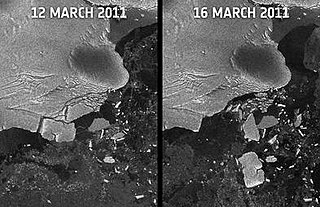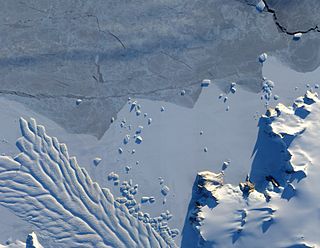Related Research Articles

The Byrd Glacier is a major glacier in Antarctica, about 136 km (85 mi) long and 24 km (15 mi) wide. It drains an extensive area of the Antarctic plateau, and flows eastward to discharge into the Ross Ice Shelf.

Sulzberger Bay is a bay indenting the front of the Sulzberger Ice Shelf between Fisher Island and Vollmer Island, along the coast of Marie Byrd Land, Antarctica.
Uranus Glacier is a glacier on the east coast of Alexander Island, Antarctica, 30 kilometres long and 10 km (6 mi) wide at its mouth, flowing east into George VI Sound immediately south of Fossil Bluff. Along the south face of the glacier is an east–west escarpment called Kuiper Scarp.
The Airy Glacier is a glacier 20 nautical miles (37 km) long and 6 nautical miles (11 km) wide, flowing west to the northeast portion of Forster Ice Piedmont, near the west coast of the Antarctic Peninsula.
Hag Pike is a conspicuous rock column, 710 metres (2,330 ft) high, on the north side of the Wordie Ice Shelf near the west coast of the Antarctic Peninsula. Together with the mountain to the north, it forms the west side of the mouth of Hariot Glacier. Hag Pike was photographed from the air by the British Graham Land Expedition, 1937, and by the Ronne Antarctic Research Expedition, 1947. It was surveyed by the Falkland Islands Dependencies Survey, 1948–50, and 1958. The name by the UK Antarctic Place-Names Committee is descriptive, "hag" being the stump of a tree which remains after felling.
Prospect Glacier is a glacier between Kinnear Mountains and Mayer Hills, flowing north into Forster Ice Piedmont on the west coast of Antarctic Peninsula. It was first roughly surveyed in 1936 by the British Graham Land Expedition (BGLE) under Rymill. In 1954 the United Kingdom Antarctic Place-Names Committee (UK-APC) gave the name Prospect Pass to a col between Eureka Glacier and the glacier here described. During resurvey of the area by the Falkland Islands Dependencies Survey (FIDS) in 1958, the col was found to be an indeterminate feature, while this glacier is well marked and requires a name.
Mount Castro is a mountain, 1,630 metres (5,350 ft) high, on the north side of Seller Glacier, 5 nautical miles (9 km) southeast of Mount Gilbert, in the central Antarctic Peninsula. It was photographed from the air by the British Graham Land Expedition in 1937, and by the Ronne Antarctic Research Expedition in 1947. It was surveyed from the ground by the Falkland Islands Dependencies Survey in December 1958, and named by the UK Antarctic Place-Names Committee for João de Castro, a Portuguese navigator who made pioneer experimental investigations of the variation of the magnetic compass.

Wubbold Glacier is a steeply inclined glacier, 8 nautical miles (15 km) long, flowing south from the Havre Mountains, situated in the northern portion of Alexander Island, Antarctica. The glacier drains the north, west and southwest slopes of Mount Pontida, and flows into Lazarev Bay north of Mount Holt. It was photographed from the air by Ronne Antarctic Research Expedition in 1947 and was mapped from the photographs by Falkland Islands Dependencies Survey in 1960. Named by Advisory Committee on Antarctic Names for Commander J.H. Wubbold, USCG, commanding officer, USCGC Northwind, U.S. Navy Operation Deepfreeze, 1977.
Bartók Glacier is a glacier, 7 nautical miles (13 km) long and 3 nautical miles (6 km) wide, flowing southwest from the southern end of the Elgar Uplands in the northern part of Alexander Island. It was first photographed from the air and roughly mapped by the British Graham Land Expedition in 1937, and more accurately mapped from air photos taken by the Ronne Antarctic Research Expedition, 1947–48, by D. Searle of the Falkland Islands Dependencies Survey in 1960. It was named by the UK Antarctic Place-Names Committee after the Hungarian composer Béla Bartók.
Confluence Cone is a small but conspicuous nunatak 4 nautical miles (7 km) southeast of Sickle Mountain, near the west coast of the Antarctic Peninsula. It was photographed from the air by the Ronne Antarctic Research Expedition in 1947. It was surveyed from the ground by the Falkland Islands Dependencies Survey in 1958, and so named by the UK Antarctic Place-Names Committee because of its position at the confluence of several glaciers which merge with Hariot Glacier to flow into the Wordie Ice Shelf.

Coulter Glacier is a steeply inclined glacier, 5 nautical miles (9 km) long, flowing south from the Havre Mountains, northern Alexander Island, into Kolokita Cove in Lazarev Bay, Antarctica. The glacier was photographed from the air by the Ronne Antarctic Research Expedition in 1947 and mapped from the photographs by the Falkland Islands Dependencies Survey in 1960. It was named by the Advisory Committee on Antarctic Names for R.W. Coulter, Master of USNS Alatna during U.S. Navy Operation Deepfreeze, 1969.
Tumble Glacier is a glacier extending along the east side of Alexander Island, Antarctica, 7 nautical miles (13 km) long and 3 nautical miles (6 km) wide, which flows east from the cliffs of Mount Egbert, Mount Ethelwulf and Mount Ethelred of the Douglas Range into the west side of the George VI Ice Shelf that occupies George VI Sound immediately south of Mount King. The glacier was first roughly surveyed in 1936 by the British Graham Land Expedition under Rymill. Resurveyed in 1948 by the Falkland Islands Dependencies Survey, and so named by them because of the extremely broken condition of the lower reaches of the glacier.
Mount Gunter is a conspicuous mountain, 1,970 metres (6,460 ft) high, with precipitous black rock cliffs on its west side, rising at the south side of Hariot Glacier, 3 nautical miles (6 km) east of Briggs Peak, on the west side of the Antarctic Peninsula. It was first roughly surveyed by the British Graham Land Expedition in 1936–37, and was photographed by the Ronne Antarctic Research Expedition in November 1947. It was surveyed by the Falkland Islands Dependencies Survey in 1958, and was named by the UK Antarctic Place-Names Committee after Edmund Gunter, an English mathematician whose "line of numbers" (1617) was the first step toward a slide rule; in 1620 he published tables of logarithms, sines and tangents, which revolutionized navigation.

Matusevich Glacier is a broad glacier about 50 nautical miles long, with a well developed glacier tongue, flowing to the coast of East Antarctica between the Lazarev Mountains and the northwestern extremity of the Wilson Hills.
Doyle Glacier is a glacier flowing to the west coast of Graham Land on both sides of Prospect Point. It was charted by the British Graham Land Expedition under John Rymill, 1934–37, and was named by the UK Antarctic Place-Names Committee in 1959 for Sir Arthur Conan Doyle, the first Englishman to make a full day's journey on skis, in March 1893.
Gibbs Glacier is a glacier, 15 nautical miles (28 km) long, flowing southeast into the northern part of Mercator Ice Piedmont on the east side of the Antarctic Peninsula. This feature together with Neny Glacier, which flows northwest, occupy a transverse depression between Mercator Ice Piedmont and Neny Fjord on the west side of the Antarctic Peninsula. Gibbs Glacier was photographed from the air and first mapped by the United States Antarctic Service, 1939–41, and the Ronne Antarctic Research Expedition, 1947–48. It was named by the UK Antarctic Place-Names Committee for Peter M. Gibbs of the Falkland Islands Dependencies Survey, a surveyor at Horseshoe Island, 1957, and leader at Stonington Island, 1958, who was responsible for the first ground survey of the glacier.
Morgan Upland is a featureless undulating snow plateau in the central Antarctic Peninsula bounded by Cole Glacier and Clarke Glacier on the north and west, by Weyerhaeuser Glacier on the east, by Airy Glacier on the south, and Hariot Glacier on the southwest. The area was photographed from the air in September 1962 by the British Antarctic Survey (BAS) air unit, and the photos were used by BAS surveyor Ivor P. Morgan, for whom the upland is named, who compiled a map over the period 1961 to 1964.

Hoek Glacier is a glacier flowing into Dimitrov Cove northeast of Veshka Point on the northwest coast of Velingrad Peninsula on Graham Coast in Graham Land, Antarctica, southward of the Llanquihue Islands. It was charted by the British Graham Land Expedition under John Rymill, 1934–37, and was named by the UK Antarctic Place-Names Committee in 1959 for Henry W. Hoek (1878–1951), a pioneer Swiss ski-mountaineer and author of one of the earliest skiing manuals.
McClary Glacier is a glacier 10 nautical miles (19 km) long and 2 nautical miles (4 km) wide on the west coast of Graham Land, Antarctica. It flows southwest along the north side of Butson Ridge into Marguerite Bay between Cape Calmette and the Debenham Islands. The glacier was first roughly surveyed by the British Graham Land Expedition, 1936–37, and resurveyed by the Falkland Islands Dependencies Survey, 1946–50. It was named by the UK Antarctic Place-Names Committee for George B. McClary, father of Nelson McClary, mate on the Port of Beaumont during the Ronne Antarctic Research Expedition, 1947–48.
Remus Glacier is a glacier, 8 nautical miles (15 km) long, which flows from the north slopes of Mount Lupa northwestward along the northeast side of the Blackwall Mountains into Providence Cove, Neny Fjord, on the west coast of Graham Land. The lower reaches of the glacier were first roughly surveyed in 1936 by the British Graham Land Expedition (BGLE) under Rymill. Resurveyed in 1948-49 by the Falkland Islands Dependencies Survey (FIDS), who so named it for its association with Romulus Glacier, whose head lies near the head of this glacier.
References
- ↑ "Hariot Glacier". Geographic Names Information System . United States Geological Survey, United States Department of the Interior . Retrieved 2012-05-23.
![]() This article incorporates public domain material from "Hariot Glacier". Geographic Names Information System . United States Geological Survey.
This article incorporates public domain material from "Hariot Glacier". Geographic Names Information System . United States Geological Survey.